Vol. 2, Issue 50 - March / April 2014
Posted: Friday 14th March 2014
This is number 50 in the second series of Lightweight News. The first fifty were known as Cambridge Lightweight News and I have played with that name in this second series. Cambridge Lightweight News sounds good, and the first few concentrated on what we were doing at home here in Cambridge. Soon we began to spread our wings and had contributions from around the world so the word Cambridge maybe gave the wrong impression of a parochial publication – who knows? However, we dropped the Cambridge although I sometimes absent-mindedly include it in the title.
Another real improvement to cycle accessories over the years has been in the realm of lights. I was brought up in the world of the Ever Ready front light with a screw-in knob/switch and the rear light which was switched on by rotating the rear section of the lamp until a spring compressed enough for the contact to complete the circuit. I can remember the battery was known as a U2. The front light would be mounted on a bracket which would be fixed either to a braze-on boss on the front fork, or if not available, behind the front tracknut on the offside. With a bit of luck and a new battery the beam would just about reach the tarmac road surface ahead, but as hard up apprentices we would try to squeeze out the last bit of ‘power’ from the battery. When the beam didn’t reach the front rim we knew it would soon be time to give up on a bag of chips or a Lyons fruit pie and buy a new battery.
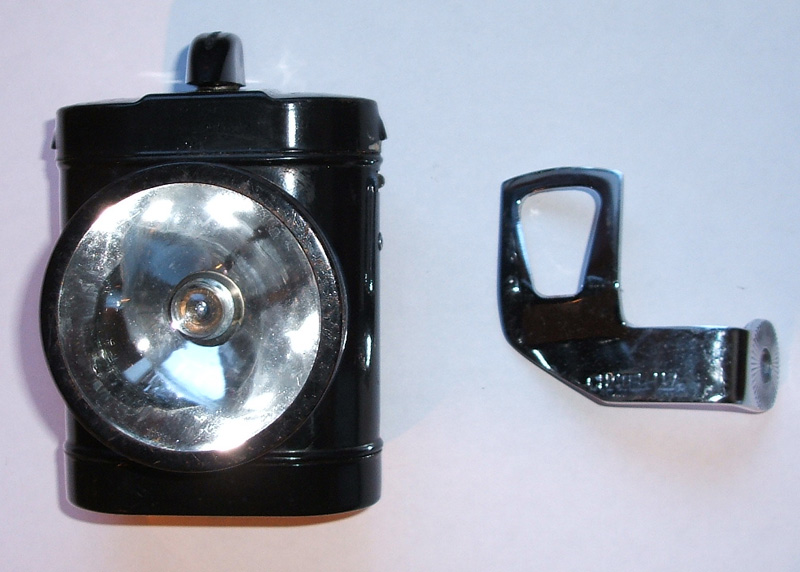
Lamp brackets are also collected, the most prized being the Constrictor alloy shown below with nut to stop the Ever Ready jumping off. With the chromed steel brackets it was prudent to use a well-worn toe strap to keep the devil on when riding over bumpy roads. Well-worn as the new ones were too thick and stiff to do the job. Also, who would want to chop down a new strap?
Next in the lamp bracket pecking order for lightweight owners would probably be the Chater-Lea chrome shown in the first image. Raleigh collectors would die for the RRA ‘Heron’ bracket and Hobbs owners cherish the Hobbs Lytaloy below.
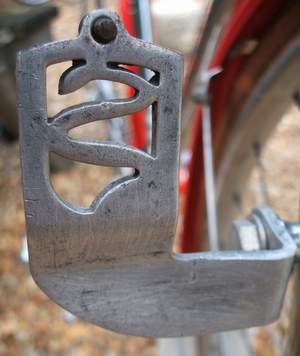
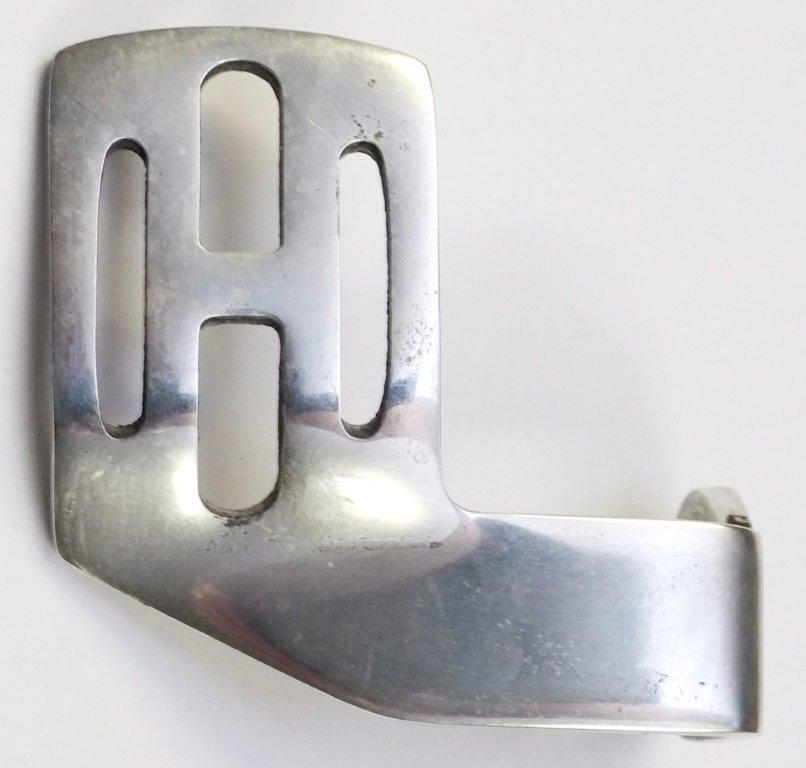
Back to the actual lights though – what a change these days! Recently Santa saw fit to put a couple of Lezyne ‘Femto Drive’ lights in my Christmas stocking (in exchange for a mince pie and a glass of sherry – not a bad deal as it was cheap cooking sherry and I guessed he wouldn’t notice after a glass at all the previous visits). These lights come in front or rear versions. I had two fronts as my winter road bike has a very good 5-LED rear light already. I should point out that I never ride on unlighted rural roads after dark anyway and all night-time cycling is around the town on shopping trips, visits to the theatre and the like, on a town bike with its own lighting system.
The lights on the winter road bike, Van Nicholas titanium with mudguards, are for the times when, although officially daylight, light is not so good and most drivers switch on their lights. I like to do the same unless on cycle-specific paths such as the guided busway to St Ives from Cambridge. I had a strap-on Cateye light which worked well enough but looked a bit ‘untidy’ on the bars – you can tell what a poseur the writer is. These new lights are a mere 25mm long and 25mm wide and powered by a couple of the ubiquitous 2030 batteries – they are so bright that if you look into the lights when switched on it is some time before your eyes adjust to enable you to see again.
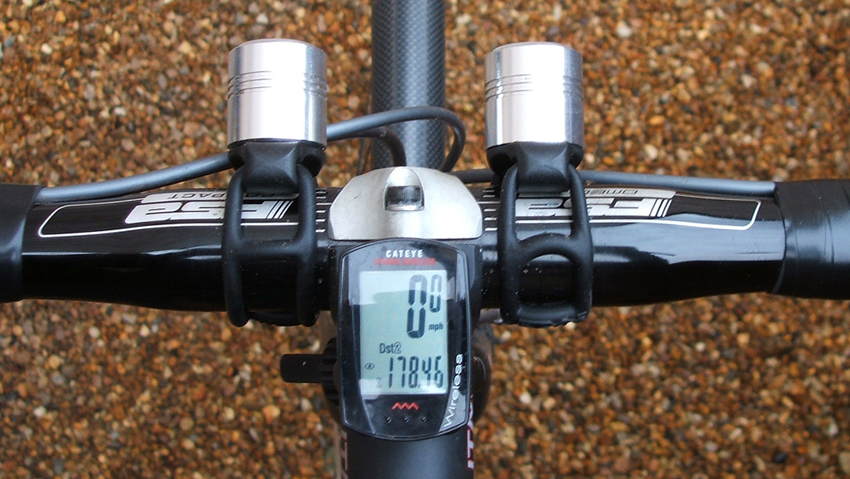
One day we were going down to London for a special ride and we were concerned that we may not quite make it back to King’s Cross railway station in broad daylight. As we were riding classics in an organised special event we didn’t want to fix modern lights. I had two sets of small clip-on lights, one with one-LED and the other with two. I tested them in the garden and again I was amazed at the output. I took the two sets with us in a pocket and we slipped them on at the finish of the organised part of the ride.
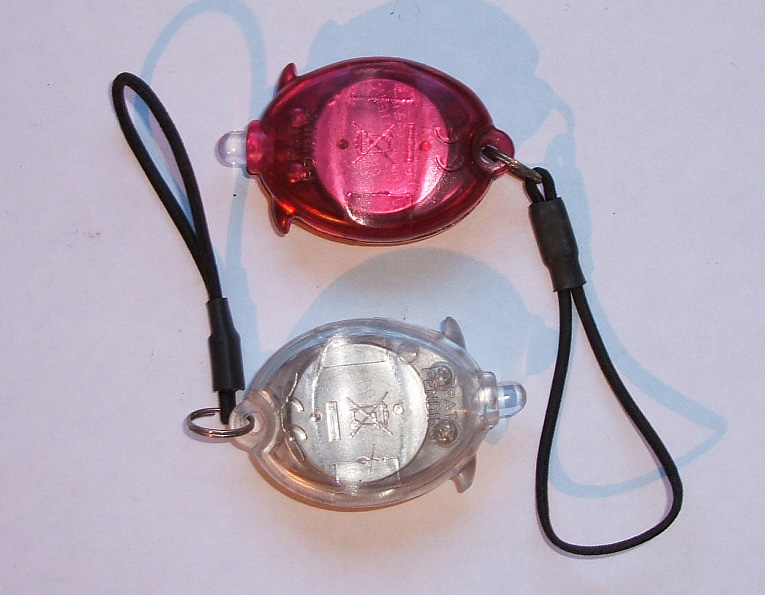
I have been talking about reasonably cheap lights (Lenzyne £13) so far and they all produce fantastic light front and rear. People who do more leisure activities after dark on their bikes often spend much more money and soon you are in a completely new realm with lights able to dazzle you from over 100 metres away, some with the ability to reduce light output as and when needed. This extends battery time of course.
The buoyant new fixed-wheel movement has been known to upset older members of the veteran cycle world and some of their contemporaries. Remarks such as, “they know nothing about it, don’t know what they are talking about – we had fixed before they were born” are often bandied about. I recently saw a question on the London FG&SS Forum asking about the strength of a bolt-on system for the rear sprockets, a system which replaces the screw on sprocket and locknut we traditionalists are all so familiar with. I found the published answer rather disproved the previous criticism:
“It has 3 bolts because that’s a way of getting the chain to clear the bolt heads on a small 15T sprocket. Worst case for a bolt on sprocket is likely to be a 2:1 drivetrain plus a heavy bloke on long cranks, applying 2000N at a radius of 180mm for 360Nm at the crank, reduced to 180Nm at the sprocket due to the gear ratio. Bad news on a 1.370″×24tpi thread, where the suggested tightening torque is about a quarter of that. The bolt circle radius is 22mm, so the shear load on all the bolts is ~16kN, and the material cross section is 12.5mm² per bolt. I think the suggested maximum shear load on grade 12.9 bolts is about 170N/mm² for cyclic loads, so 2100N per bolt, 6.3kN if all 3 share the load equally. This is ignoring any friction between the sprocket and mounting face, which is probably a reasonable assumption, and there are big safety factors in there to allow for a safe cycle time of 2 million cycles. So, a fat bloke doing a maximal standing start on a low gear won’t snap the bolts immediately, and he can do 1 million revolutions at around 40% of starting torque before the bolts fail from fatigue. A million revs on a 52″ gear at a nice low climbing cadence of 50rpm and 800Nm peak torque at the crank is 1900W peak power output, 8mph and 2600 miles travelled. We need somebody with a Watt bike to tell us the peak:mean torque ratio, but just looking at the polar graphs suggests to me that even absolute duffers manage about 4:1 and elites can get to 2:1, so average power output of 475W even for a clumsy fat mountain biker.”
“ISO freewheel on a British-threaded hub.
Polo gearing 38 : 22 = 1.727:1 175mm arms 2000N => 202Nm at the threads
80kg rider doing standing starts
Schwalbe Kojak 35-559 on a XC717-Disc rim at 80psi => 630mm rolling diameter?
Absorbing the torque peaks: 32 spoke 3-cross DT Competition 2.0-1.8-2.0 with the inner spokes all trailing, Izumi Standard 1/8th chain, Goldtec “DH” SS ring on Shimano XT M770 cranks , M770 SPDs, decent “carbon” Northwave mtb shoes…”
And to think I just screw up the sprocket as hard as possible with a chain whip and do the same with the locking ring tool – none of the old hammer and punch these days.
We recently took a winter break in Berlin and planned to do design and art by day, plus three evenings at the Berlin 6-day tack races. An ideal programme really as visiting art galleries and sightseeing is always quite taxing and this allows an evening sitting down watching the competitors earning their money the hard way. At Berlin the programme included the sixteen teams from Austria, Belgium, Czechoslovakia, Denmark France, Germany, Spain, Switzerland and the USA in the main event plus fifteen international riders in the Ladies Cup, seven in the stayers motor-paced event and six top sprinters in the separate Champions Sprint International event.
The main 6-day event is comprised of sprints, Derny racing, Devil-Take-the-Hindmost, etc but the backbone of the event is the Madison where laps can be won or lost due to a moment’s lack of concentration. The other events riders score points and the winner is the team with the most laps gained, with a dead heat on laps settled by most points scored. The Derny events are always very exciting being conducted at high speeds behind the Derny pacing bikes and the sight of three teams battling it out side by side around the steep banking is quite exhilarating. An additional thrill is seeing the two riders change position behind the bikes after twenty five of the scheduled fifty laps. This is done by the replacement rider dropping down off the banking and getting a hand-sling to put him firmly on the wheel of the pacer. The thing to remember is that it is not just the one machine on the track but eight battling for position while this happens. The changeovers are so smooth that one bat of an eyelid and you have missed it.
The final Madison is always a cliff-hanger as each rider in the winning team of two will win a car plus a handsome amount of cash and this year was no exception as the chase went on right to the last few laps. The atmosphere was electric and the Berlin crowd nearly all have whistles which they blow frantically when things get exciting, this along with the cheering went on right until the final gun. The supporting events were equally as exciting so we had good value for our money. The eventual winners, just pipping the home favourites by a lap, were the Belgian, Kenny de Ketele (riding a Merckx), and Austrian, Andreas Müller.
The Berlin Velodrome is in what was the old East Germany and the velodrome and the adjacent Olympic style swimming pool were right next to the Landsberger Allee S-Bahn station and tram stops. We took a hotel within a ten-minute walk of both which meant that was an easy trip back to the hotel after the racing. We were lucky in the choice of hotel as they looked after us very well and it was but a short trip on the tram into the centre of Berlin. The rooms in the hotel were really warm and always a pleasure to return to on the winter days and nights (-10 ͦC and below and packed snow underfoot) and the buffet breakfasts were as good as we have seen.
Purely by coincidence Your Honour, the same distance in the opposite distance was a classic bike shop, Steel Vintage Bikes, which I was aware of through the internet but had not visited so we arranged to meet them whilst in Berlin. I must say that it was one of the smartest and most inviting shops I have been in and as a bonus their stock of steel classics would make any enthusiast drool.
The operation at Steel Vintage Cycles is very slick and professional from the showrooms through to the gleaming workshop with its own photographic studio for documenting and publicity of bikes for sale. The back office accommodation is very smooth looking, as it would have to be to handle some 235 bicycles shipped to customers all over the world last year. About 12% were sold to UK , Australia was their 2nd best customer and Germany was in third place.
I must say that we were made very welcome at S V C and would love to see them again – call in if you are in Berlin but it would be wise to check opening hours on their website before you go. They are a very short walk from the Frankfurter Tor U-Bahn station.
Before they moved the operation to Berlin from Freiburg in the Black Forest some of my friends bought cycles from S V C to ride in L’Eroica, and they were very pleased with the service they had and with the quality of what they purchased which was unseen of course, other than from online images.
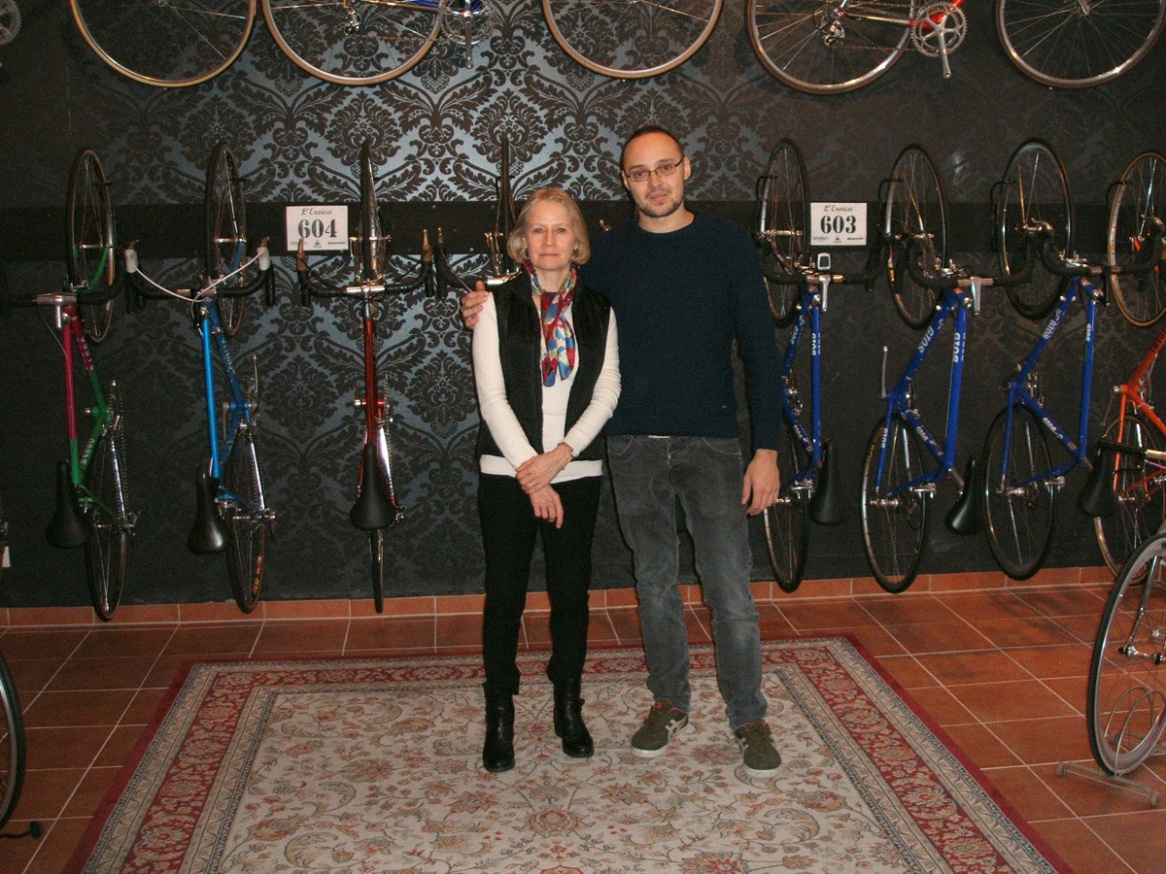
Following our visit, Steel Vintage Cycles have given us a very flattering review on their blog.
On a personal note I was looking for an immaculate 59cm c-to-top Colnago Master Olympic (Gilco tubing), ideally with Art Decor paintwork and with 130mm rear ends. They had two beautiful examples at Steel Vintage Cycles but sadly they were 57cm which is just too small for me in the older style machines. One was already sold to the Middle East and was to be equipped with everything possible from Brooks. I guess it will be a long wait for the right one for me to come along as frames in this condition are hard to come by, and I don’t think it is possible to get Art Decor restorations done at your average restorer as the finish is so highly technical. Another problem is that many Colnago are 55 or 57cm in size, possibly something to do with the average Italian height being slightly less than the UK. Since I first wrote this paragraph I have bought a Colnago Master X-Light Competition- don’t worry, you will hear all about it in the next issue!
Ever since having seen such a pristine Colnago Master machine at a meeting organised in Oberammergau in Germany I have hankered after one. The example there, which I guess was built from a brand new Colnago Master Olympic frame, was fitted with modern Shimano top-of-the-range Dura Ace gearing and had the iconic Delta brake stirrups by Campagnolo. The owner used it in the Alps hence the modern slick gearing and presumably he had been able to set up the brakes to cope with downhill mountain roads. Deltas are a joy to look at but they have this reputation for being very difficult to adjust for efficient braking. I have quite a lot of 9-speed Dura Ace equipment taken from the custom-built Reynolds 853 steel machine which was replaced by my carbon Colnago and I also have a pantographed ITM stem with ITM bars and a pantographed chainring plus two sets of wheels to choose from so nearly there.
The build of this will take me into a new field, Italian threads in bottom bracket for a start and possibly Campag chainset. If I were to add to my Italian collection (1957 Cinelli, 2000 Colnago Master and new carbon Colnago) then it would be a Cinelli Super Corsa as they list high among my favourites. In the world of steel classic frames both the Colnago Master and the Cinelli Super Corsa must be amongst the longest-running examples as they are both produced to this day to satisfy the demand for well-respected steel frames.
My 853 machine mentioned above has now got a new owner who will restore and build largely as it was when purchased some eighteen years ago. It was built by Paul Donohue in the NE of England. Paul was a respected builder in those days although he left frame-building some years ago. I don’t think it is easy making a living as a custom frame builder and Paul saw better chances elsewhere. His history is not old enough to excite collectors of older classics but he has a good following amongst the fixed-wheel fraternity subscribing to the LFG&SS Forum. His track machines are highly sought after for fixed-wheel builds and his road frames are also often built for use on the road with gears. Another builder very popular amongst the fixed-wheel users is Donhue, which can cause some confusion. Donhue is exhibiting at the Bespoke Show detailed below.

Good news for us is that this year’s Bespoked – The UK Hand-built Bicycle Show will be held in London rather than in Bristol, the venue for the past few years. It is at Lea Valley Velopark from 11 – 13 April, just a few weeks away at the time of writing. “The Velodrome is a truly amazing building and the show will take place during the first few weeks of it being open to the public after the Olympics. The space inside will act as a perfect backdrop to some of the most amazing bicycles on the planet and those that make them.” For us London is 45-minutes on a non-stop train and a bonus will be to see the Velodrome where the 2012 Olympics took place. The list of exhibitors is very impressive. This venue is re-opening after a post-Olympics revamp. If you are interested in hand-built frames and bikes, this is the place to go for sure – you won’t be disappointed. Perhaps we’ll see you there on the Saturday.
Nigel Scott (Campy Oldy)
When turning out some parts for restoration of a Phillips chain drive trike for grand-children (seeking unthreaded cones for rear axle!!) I found these Campag cones. I don’t remember where I got them originally but as you see on the backs is stamped 8 x 26 and 9.5 x 26 rather than their normal 9mm and 10mm for both solid or quick-release hollow axles.
The 8mm cone screws on to a known Airlite 5/16″ front axle and the 9.5mm screw onto a standard BSC 3/8″ rear.
I have made no attempt to discover why or when Camp decided to make cones to fit BSC axles. I won’t feel any better if I spent time and got a result so will leave it to your readers to ponder. I can’t get figures any sharper on the 9.5 rears, they are stamped less heavily.
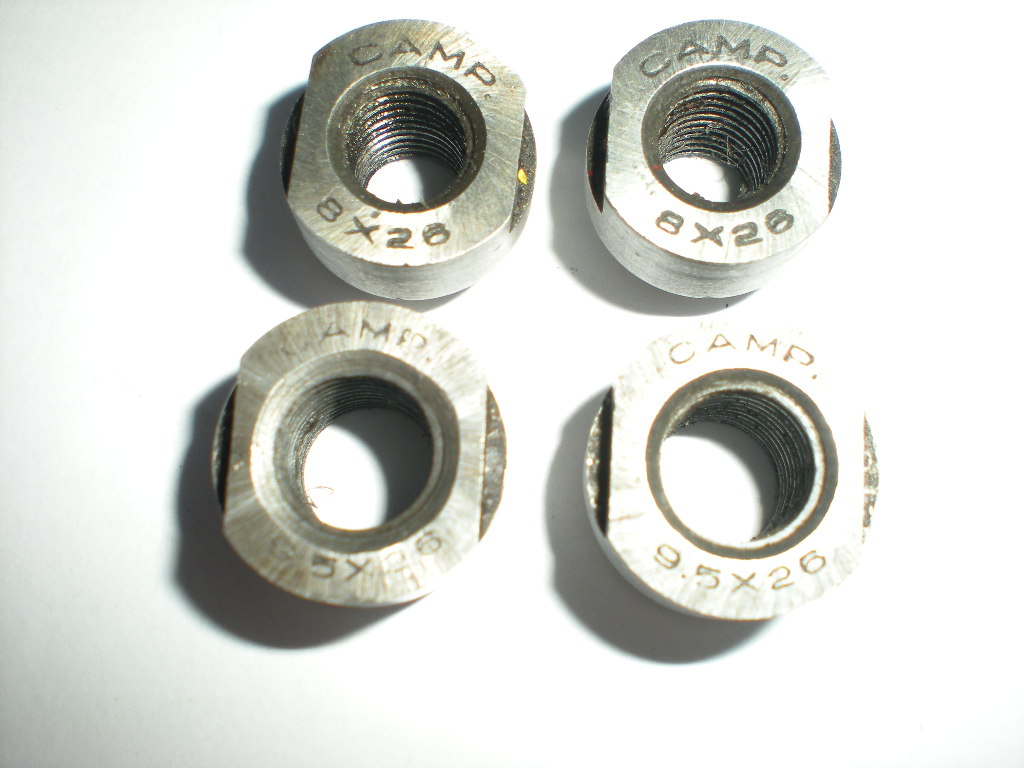
John Ketley (Denmark)
Greetings from Denmark and looking out of the window at the moment, the Siberian cold (CFactor -15) dry condtions have changed to snowy Siberian weather curtailing further ”mad dogs” etc.biking.
As regular reader of your marvellous CL website and monthly letters Peter, it came to mind that you could perhaps direct your readers to Alf Buttler’ s marvellous large blog “What’s it all been about, Alfie” with a large dose of historic social life and cycling through the 30s 40s and 50s, in and around the Midlands Derby- Notts.
alfbuttler.blogspot.com
Plenty of League and The Crowthers are mentioned among many others. I found from one of your early CLs mention of Northwood Cycling Club diaries of the forties and fifties, and reading through it to my might great surprise I found that Saunders and myself completed in Feb 52 a 100 in seven (what a way to break in a new B17) reliability ride “together”, and in my case, was my first real dabble into more serious cycling complete with NEW Stallard Zakopane bike, all of one month old (taken five years to save for).
He shows photo of himself taken at a WLCA 25 (Bath Road) in May 53. I have an identical photo of myself taken thirty minutes before him. “Small world” indeed.
“With a foot in both camps”, NCU and League, I competed regularly during 1952-53 until Army National Service beckoned me into her warm bosom and on return from “the Canal” (Egypt – Ed) in 1955, my last massed-start race was on the Dunmow circuit, won by my old club mate who was flying high at that time and went on to ride pro for Fred Dean Cycles, while I went literally south for three years in the Antarctic. So ending my serious cycling.
The Stallard, complete with Brooks B17, still hangs on the wall along with memories. There is also a 1947 Claud Butler International and down on the floor a 1980 Mercian Pro. Plus a couple of more modern bikes.
I have been living in Denmark since 1966 after working in oil exploration up through the 1950s-60s as land surveyor. The classic lightweight scene in Denmark is virtually non-existent with just the “odd bob” popping up now and again, but the interest in cycling both urban and for pleasure/competition is very much alive here. Copenhagen had recently a police cycle check with over two thousand fines being giving out for traffic violations and this is winter we are talking about. I would imagine on any single day that at least a hundred thousand cyclists are in motion in Copenhagen alone.
It must be evolution as bike riders of today, or many of them, are very tall. I had to have my 24in Stallard made specially, the Mercian is 25in, and the number of CL frames in OUR! sizes are few in numbers it would seem.
PS On my return to England from India in 1947, I was given by my favourite Derby/Mercury/League cousin my first copy of “The Bicycle” and I became “A prisoner for life” spent hours glued to Mercian’s shop window when up on holidays from London. I also “spent time” at Ken Ryall and Ferris to name JUST A FEW of the locals.
Is the EG Bates bike in the attached picture of any interest to our readers? It belonged to a (very) old friend of mine who died last year (aged 95). He was a fixed wheel enthusiast and in his heyday (1940’s/50’s) he belonged to a north London cycle club. I’m not sure if it was his competition bike (with practical bits added) or whether it was one he bought after he finished riding competitively. The bike has been in a garage for years but amazingly it stills rolls along very smoothly.
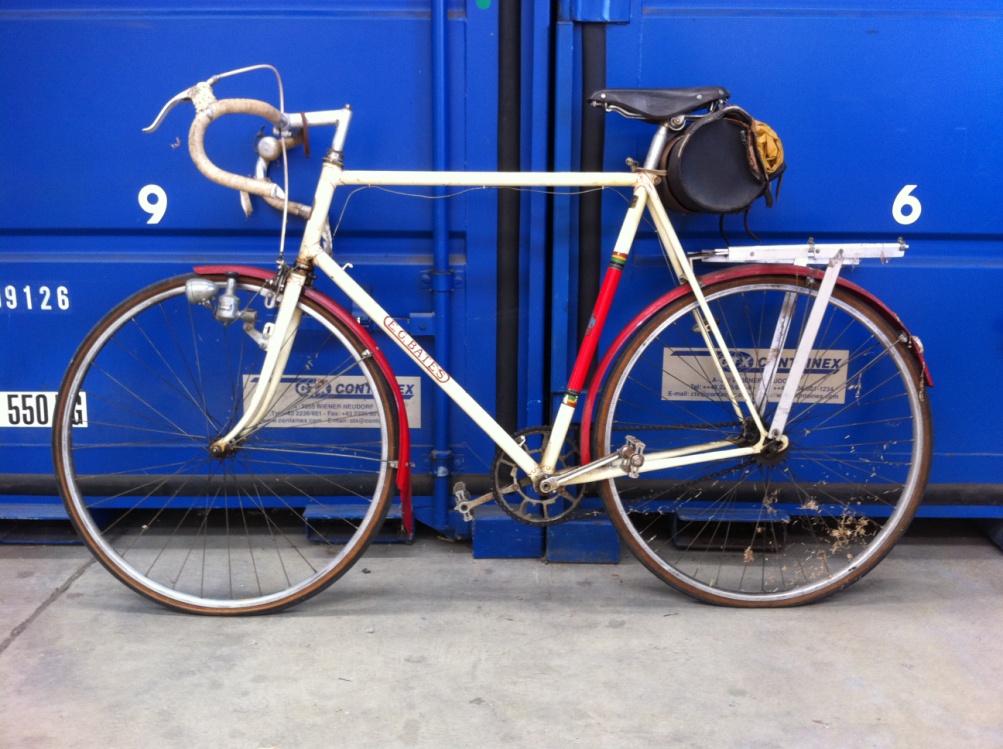
Patricia still has some of her small bikes for sale as mentioned in L News 49:
1950 Ephgrave No. 1 – 20½” frame, Fiamme sprint rims built with 15/17G spokes onto Harden Bacon Slicer large-flange hubs, Chater-Lea round crank single chainset on Chater BB. Simplex 5-speed Tour de France gear, GB alloy Spearpoint stem with the rare Capo Berta bars, Mansfield laced saddle. Various wheel specifications available with price difference. Will split.
1944/5 Bates BAR – 19½” frame, Fiamme sprints on Airlight large-flange hubs, Chater-Lea single chainset with round cranks, Simplex 4-speed Tour de France gears , very rare early Burlite levers and stirrups, GB alloy Spearpoint stem with the very rare Capo Berta brakes, Brooks B15 saddle, Again, will consider various specifications or will split. Both collection from Cambridge.
Both bikes can be seen in Readers’ Bikes with (PK) after listing. Contact using details at top of Newsletter.
Posted: Friday 14th March 2014
Contents
- Introduction
- Ever Ready Lamp
- Lamp Brackets
- Conloy Alloy Lamp Bracket
- Femto Drive
- Femto Drive Lights
- Special Ride
- LED Lights
- Cheap Lights
- ISO Freewheel
- The Final Madison
- Steel Vintage Bikes
- Steel Vintage Cycles
- Vintage Cycles In Showrooms
- Colnago Master Olympic
- Campag Chainset
- Nigel Scott
- Camp 8X26
- John Ketley
- Chris Grimsley
- Bicycle
- Bikes For Sale
This article appears in the following categories.
Upcoming Events
Whether you are looking for a gentle social meet up, or a 100-mile ride browse the community’s upcoming events and plan your next weekend outing.
